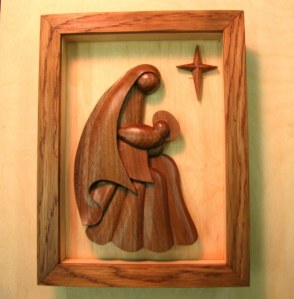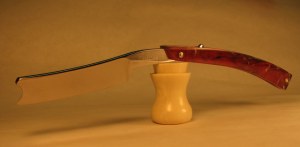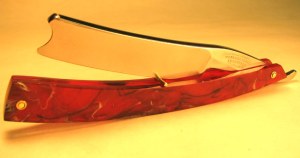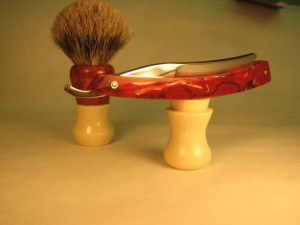for today just a small update, but i think nevertheless an important step in the carving. i have approximately fixed the proportions, and the big planes and angles…
portrait bust – part 3
22 Jan 2011 8 Comments
in woodcarving Tags: bust, portrait, sculpture, woodcarving
A Different type of Slice!
19 Jan 2011 Leave a comment
in woodcarving Tags: brushes, razors, shaving
No, it’s not slicing as with chisels. Sorry.
It’s a hobby of mine. Getting antique straight razors and restoring them. Some I keep, some I sell along with the custom shaving brushes that I make as well. Believe it or not, there is quite a market for these items. I collect these, antique shaving brushes that I restore as well, double edge razors of all styles with the most popular being Gillette.
This particular razor I took on a trade. As you can see it was in rather sad shape but it’s a popular brand and an excellent shaver once restored and honed to shaving standards. Yeah,, I like sharp tools of all types. And really, did you expect a carver who makes a living with a mallet and chisel to shave with an electric razor? No, I was born in the wrong century making a living the way I do, so my razor had to be from the same period as well. Using one of these will teach you how to control an edge very quickly.
As far as sharpness goes, do you think your chisels are sharp? You might think so if you can shave hair from your arm with one. That’s sharp. But here is a test for a razor. Pluck a hair and hold it with your thumb and index finger. Now, about a half inch away from your fingers, try and cut the hair as it hangs free. It’s called a hanging hair test. This razor will start over half an inch away and you can slice that hair like a baloney right along it’s length . I can pass it along my arm, keeping it a half inch away from my skin and it will shear off hair like it isn’t even a thought. That’s about as sharp as you can get.
So as to the restoration I broke the razor apart as it needed so much attention. The scales ( handles) were originally bone, but they too were cracked and in bad shape. I cleaned up the razor, straightened out the edge and generally polished it up. I left the hollow grind of the blade itself in a brushed finish.
The scales are something I made out of resin as I make pretty much all my own stock. Sometimes I’ll use exotic woods on the razors, but here I wanted something more dramatic. In the field of collecting and selling this is becoming the norm. The pins that hold the handles together I made as well and those washers under the pins are about 1/8th inch.
The brush you see I made as well . Here I made the “Ivory” , the wood is Rosewood, and the brush is actual Silver tip Badger .
Not carving , but something I enjoy.
In these first three shots the amount of rust damage and pitting as well as unevenness of the blade is obvious.
The remaining photos are of the completed razor. Pretty much self explanatory. One interesting detail I added when I made the stock for the handles was to have the inside section clear. No particular reason for it to be that way. It does add a bit to the translucence of the scales and makes them a bit brighter. It’s difficult to see in the photos where it’s closed, but in person , you can just make out the razor blade behind the scales.
portrait bust – part 2
12 Jan 2011 Leave a comment
in woodcarving Tags: bust, portrait, sculpture, woodcarving
i have glued up the block of wood,,, and the carving has started. i began to carve the curve for the front, to help me later to get a good depth for the face.
then i marked off the essential landmarks, and made notes on the block for these measurements, to use them later again
after that, my first goal is to find the basic BIG shapes, like i explained in the previous post. in this case, i want carve first the complete front head, so it can lie down as the high relief carvings i did. when the front is completed i put the carving to stand, and cut the back… i think, this way i will have always enough space to push the carving further back, in case i make a bad mistake. if i were to cut the back of the head now too, i am limited in what i can correct… so here is what it looks now
as you can see, i concentrate on getting the big angles about right. and the main proportions. but still everything is very loose, to give enough room to find the correct shape. its not doing one or two very precise cuts, but many small ones approaching the surface to be found slowly. the carving will look blurry and clumsy quite some time, and sharpen up only when i am sure i am in the ballpark as where i want to be…
portrait bust – part 1
08 Jan 2011 2 Comments
in woodcarving Tags: bust, clay, in the round, portrait, sculpture, woodcarving, zbrush
today i want to start a sequel of posts on which i will show my carving of a portrait bust, in a little more than half of life size, and fully in the round. so, for me somewhat new terrain after all the high relief portraits …
however this project was prepared long before… it started with doing a clay model, and then cast it in plaster :
several pictures of the clay model are on my homepage. … so, i have a model to base on, to make measurements from if i feel i need to ….
i did something more, since i am curious to see how it works, to learn if it is useful… and that is, i made additionally a digital model of the same person… i used zbrush as software (zbrush from pixologic), and here is what i came up with (please click image to enlarge):
why i think this is useful is, that it shows the stages i have gone to create the head. in the top left you see the first stage, a model consisting only of a few flat planes that contain the basic proportions and the main (strong) angles. the bust in the lower left has the planes a tad bit more refined, i.e. split up into smaller planes with slightly different positions in space. we recognise now already the hair, the area where the eyes will fall, an indication of the ears, and a refinement of the shoulder area despite no details are there to actually show these … and the right images show again refinements of these with the final sculpted bust in the middle…
hey, why is she showing that on a woodcarving blog ?
because, this is at the very core of carving… i am still visiting woodcarving sites, and very often i hear “how do i carve this, how do i carve that ?” … the answer to all these questions is the same and presented in the picture above : look at your model what you want to carve, squeeze your eyes to see blurry, and you will see the basic shapes and volumes only, no details, like in the top left image above, that with the very few planes… carve that, with some “safety wood” around it, ,,, then look a tad closer, and now refine your first approach to match what you see now… go on this way, as long as you think it is needed to present what you desire to show…
i know, it sounds too simple… but really, in carving we create shapes in space, volumes,,,no matter what the subject is we carve. …
ok,,, thats for today, i have already glued up the block of wood, and started carving, soon pictures wil come from the first stage,,,
Deja Vu, part 2
06 Jan 2011 2 Comments
in woodcarving Tags: relief, religious carving, woodcarving
I’m in the final stretch now. I wrapped up the carving of the Baby and Halo, sanded the piece and applied the finish. Same as the full size piece. I also made the Star and even added the small element behind it and covered it with 23K gold just as I did on the original.
Then I made what is essentially a shadow box using the same wood, and framing it just as the original was completed. The main box is Birch with an Oak frame. At this time the box and frame haven’t received the final sealer as they are only in stain at this point. But it’s close enough that you’ll see just what the final outcome will look like.
 The completed carving with the sealer. Seeing it in my hand gives you a sense of the scale of the piece.
The completed carving with the sealer. Seeing it in my hand gives you a sense of the scale of the piece.
 I much prefer the look of a Satin finish as opposed to a gloss. Gloss I feel tends to cheapen the look by making a piece look embalmed like some craft show decoupage cr*p and in the process killing the beauty of the wood because of the gloss. Satin allows you to still see the wood giving it a soft sheen so you know it’s finished, but still looks silky. Even with the strong light so close the wood still comes through.
I much prefer the look of a Satin finish as opposed to a gloss. Gloss I feel tends to cheapen the look by making a piece look embalmed like some craft show decoupage cr*p and in the process killing the beauty of the wood because of the gloss. Satin allows you to still see the wood giving it a soft sheen so you know it’s finished, but still looks silky. Even with the strong light so close the wood still comes through.
And the Star . Not shown with the small segments that fit into the corners that was gilded. Here I strayed from the original which I did in 4 sections and did this in one piece. It still looks similar enough and at this scale nobody will really care. I don’t think they’d care or even noticed that I did the full size piece in four sections.
 Here you can see the niche concept by doing a shadow box type frame.
Here you can see the niche concept by doing a shadow box type frame.
 Came out fairly close. Not that it matters one bit, but the scale on the Oak frame would make this closer to 8 inches than the 6 inches on the full size piece. Doesn’t matter as this is just a desk or wall mounted “3D picture frame” and not a scale model that has to be totally accurate. I guess it’s just my nature showing as I was curious as to how close I came. Silly. The final interior dimensions came in at exactly 5 X 7,,, just like a photo frame. I’m happy.
Came out fairly close. Not that it matters one bit, but the scale on the Oak frame would make this closer to 8 inches than the 6 inches on the full size piece. Doesn’t matter as this is just a desk or wall mounted “3D picture frame” and not a scale model that has to be totally accurate. I guess it’s just my nature showing as I was curious as to how close I came. Silly. The final interior dimensions came in at exactly 5 X 7,,, just like a photo frame. I’m happy.
Go to page : 1 2
Deja Vu,,,just smaller
05 Jan 2011 4 Comments
in woodcarving Tags: relief, religious carving, woodcarving
I didn’t think I’d be revisiting this carving again. But just today I got a call from the Pastor and he had a request. Turns out he had the small sample I had done when I proposed this job but he gave it away. He had it mounted on his office door and everyone loved it. Especially the donor for the large statue. Well the Pastor felt he ( the donor) should have the small carving as a memento to keep at home with him.
Now the Pastor was missing his carving and wanted to replace it with another. But this time we decided to make a miniature of the full size statue for his office. This way he could set it on his desk as you would a photo in a frame,, or mount it on the wall, again , as a picture frame. The plan is to mount this carving, done in the same Walnut as the full size carving, on the same style background with some depth to it as if a shadow box and frame it with some Oak as the original was finished.
I started it tonight after dinner and at this point it’s only roughed in. As you can see the baby needs to be carved and then the rest of the piece gone over. It’s 6 inches in height and the thickness of the wood is just under 5/8ths inch. I think this is interesting for several reasons. The topic was brought up at one time in the comments as far as how thick a carving should or could be to achieve “levels” and a look of depth. The natural thought is that thicker is better. Not always. In this case having a thicker piece of wood would not look good considering the size of the carving. Any thicker than this and I might as well carve a 3D piece.
The other topic that came up recently as well here on the blog was finishing a piece. Not what type of oil, poly, wax etc. to use but how to achieve a smooth finish on a carving prior to the sealing steps. The idea of a special chisel was considered as being the solution. I disagreed. I tend to think that the best chisel to clean up a carving is the very tool that made the cuts. It’s only natural since the chisel made the cut in a particular curve so use that same chisel to clean up after itself. Now in some cases you will use a similar chisel where you need to flatten ridges created by a deeper chisel,, but in most cases, the same chisel does the job just fine.
Now on this carving at this stage, it’s only roughed in. Lines need to be addressed, stop cuts cleaned and a general going over to smooth out the main surfaces. As well as finish carving the Baby and Halo of course. But here you get the idea of the general look of my pieces as I’m working through them. Since this is so small it’s easy to keep the piece clean as you go. And truthfully, a piece this small doesn’t take much to clean up as you go in addition to the fact that once it’s roughed in, it’s pretty close to the final size. Not much more can or will be taken off. Once my roughing in is completed I’ll resharpen my chisels that I used and go over it lightly to blend odd cuts ,smooth the facets , shear the stop cuts .
The thing is, carving clean should really start at the beginning as you’re setting in stop cuts. Paying attention to just how deep you set them with a mallet or by hand so they aren’t noticeable when you are finished. You don’t want to see the lines in the wood. The stop and paring cuts should meet at the exact same depth and point. When making the paring cuts to the stop cuts be careful not to over shoot the cut and leave chisel marks in the vertical sections. These areas are the most difficult to clean up well as opposed to the smoother curved surfaces of the rest of the carving. It’s in the bottom corners where the messes tend to be. Carve cleanly in these areas as it’s easier to finish it now than go back over the whole piece picking out fuzzies for hours on end. Do it right the first time , as they say, because their is never enough time to do it the second time. It’s just good carving practice to do it this way.
 Here you can see the overall size of the piece coming in at just 6 inches.
Here you can see the overall size of the piece coming in at just 6 inches.
 Here you can see the relative thinness against my .5mm mechanical pencil. When areas get this thin delicate cuts and sharp tools are the way to go. Also, rather than making a truly vertical cut and risk the thickness of the chisel breaking off a thin piece such as this because it’s acting as a wedge, make a slanted cut instead. Once the waste wood is removed you can then shear down and make a clean vertical cut without pressuring the delicate detail you wish to keep. And yes, there is some cleaning up to do on some vertical areas where the grain tore out. Sharp chisels and careful shearing cuts will take care of these details with the final passes. Considering the scale,, and when you blow up the photo they don’t look very good,, but some of the stuff you see is the size of a grain or two of sugar. So,, not all that bad.
Here you can see the relative thinness against my .5mm mechanical pencil. When areas get this thin delicate cuts and sharp tools are the way to go. Also, rather than making a truly vertical cut and risk the thickness of the chisel breaking off a thin piece such as this because it’s acting as a wedge, make a slanted cut instead. Once the waste wood is removed you can then shear down and make a clean vertical cut without pressuring the delicate detail you wish to keep. And yes, there is some cleaning up to do on some vertical areas where the grain tore out. Sharp chisels and careful shearing cuts will take care of these details with the final passes. Considering the scale,, and when you blow up the photo they don’t look very good,, but some of the stuff you see is the size of a grain or two of sugar. So,, not all that bad.
 The same delicate area from the opposite side. The amount of wood at the very tip of the veil seems to be only a few slivers of wood grain. Easy to break off. The shadows are important to follow when carving. I generally use two lamps as I’m carving so I can keep playing with the shadows to see how the carving will read. The other reason for two is that many times your hands or tools are blocking the light as you’re making particular cuts and the second lamp illuminates your path if you happen to be blocking the light from the other lamp. Using only one lamp you’ll find yourself constantly moving it from cut to cut just to have the proper lighting. You need to see the shadows as well as illuminate the cut.
The same delicate area from the opposite side. The amount of wood at the very tip of the veil seems to be only a few slivers of wood grain. Easy to break off. The shadows are important to follow when carving. I generally use two lamps as I’m carving so I can keep playing with the shadows to see how the carving will read. The other reason for two is that many times your hands or tools are blocking the light as you’re making particular cuts and the second lamp illuminates your path if you happen to be blocking the light from the other lamp. Using only one lamp you’ll find yourself constantly moving it from cut to cut just to have the proper lighting. You need to see the shadows as well as illuminate the cut.
 And why are these pictured? Well, just for fun . They were sitting on the bench since I made them today and figured I’d include them as well. The center one was an existing brush, in terrible condition and I restored that one by removing the knot and replacing it with a new one and cleaning up the rest of the handle. The other two I made the acrylic, spun them on my lathe and then fitted knots in them as well. These are three entirely different Badger Hair Knots.
And why are these pictured? Well, just for fun . They were sitting on the bench since I made them today and figured I’d include them as well. The center one was an existing brush, in terrible condition and I restored that one by removing the knot and replacing it with a new one and cleaning up the rest of the handle. The other two I made the acrylic, spun them on my lathe and then fitted knots in them as well. These are three entirely different Badger Hair Knots.
I’ll post more photos of the carving as I get ready to sand it so you can see how I clean up a carving. After that point it’s sanding it, sealing it and then making the small star and frame. Should go quickly considering the time I have in it up to this point.
Stay tuned.
Go to page : 1 2
2010 in review
02 Jan 2011 3 Comments
in offtopic, woodcarving Tags: 2010 in review
The stats helper monkeys at WordPress.com mulled over how this blog did in 2010, and here’s a high level summary of its overall blog health:

The Blog-Health-o-Meter™ reads Wow.
Crunchy numbers
About 3 million people visit the Taj Mahal every year. This blog was viewed about 48,000 times in 2010. If it were the Taj Mahal, it would take about 6 days for that many people to see it.
In 2010, there were 32 new posts, growing the total archive of this blog to 82 posts. There were 202 pictures uploaded, taking up a total of 60mb. That’s about 4 pictures per week.
The busiest day of the year was January 5th with 565 views. The most popular post that day was Eagle.
Where did they come from?
The top referring sites in 2010 were woodcarvingillustrated.com, hobbyschnitzen.de, sawmillcreek.org, woodworkersinstitute.com, and riolama.de.
Some visitors came searching, mostly for carving bench, wood carving bench, bernini, carvers bench, and mark yundt blog.
Attractions in 2010
These are the posts and pages that got the most views in 2010.
Eagle July 2009
3 comments
Mark Yundt´s gallery May 2009
Tools I Can’t Live Without November 2009
77 comments
Welcome April 2009
Portable Carving Bench May 2009
6 comments
yes, wow !! i am so happy our blog is living and doing so well.























recent comments